The Difference Between Stock, Broth, and Bouillon and A No-Fail Recipe!
Stock. Broth. Bouillon. Do you ever wonder about their difference? Here’s what my research uncovered:
They are all words for the liquid part of soup, right? Yes... and no. Although these terms are often used interchangeably, professional chefs will insist that there are distinct differences between the three. This is especially true between stock and broth. Unfortunately, even the chefs don't seem to agree on exactly what those differences are.

But there is a little middle ground. And you’ll find it in bouillon. Bouillon is the least controversial. Most chefs use "bouillon" as a term for dehydrated stock or broth that is later rehydrated for use.
Bouillon is commercially produced for home use in the form of cubes and powders. While it can add a solid flavor punch to a recipe, the drawback with commercially produced bouillons is their high salt content.
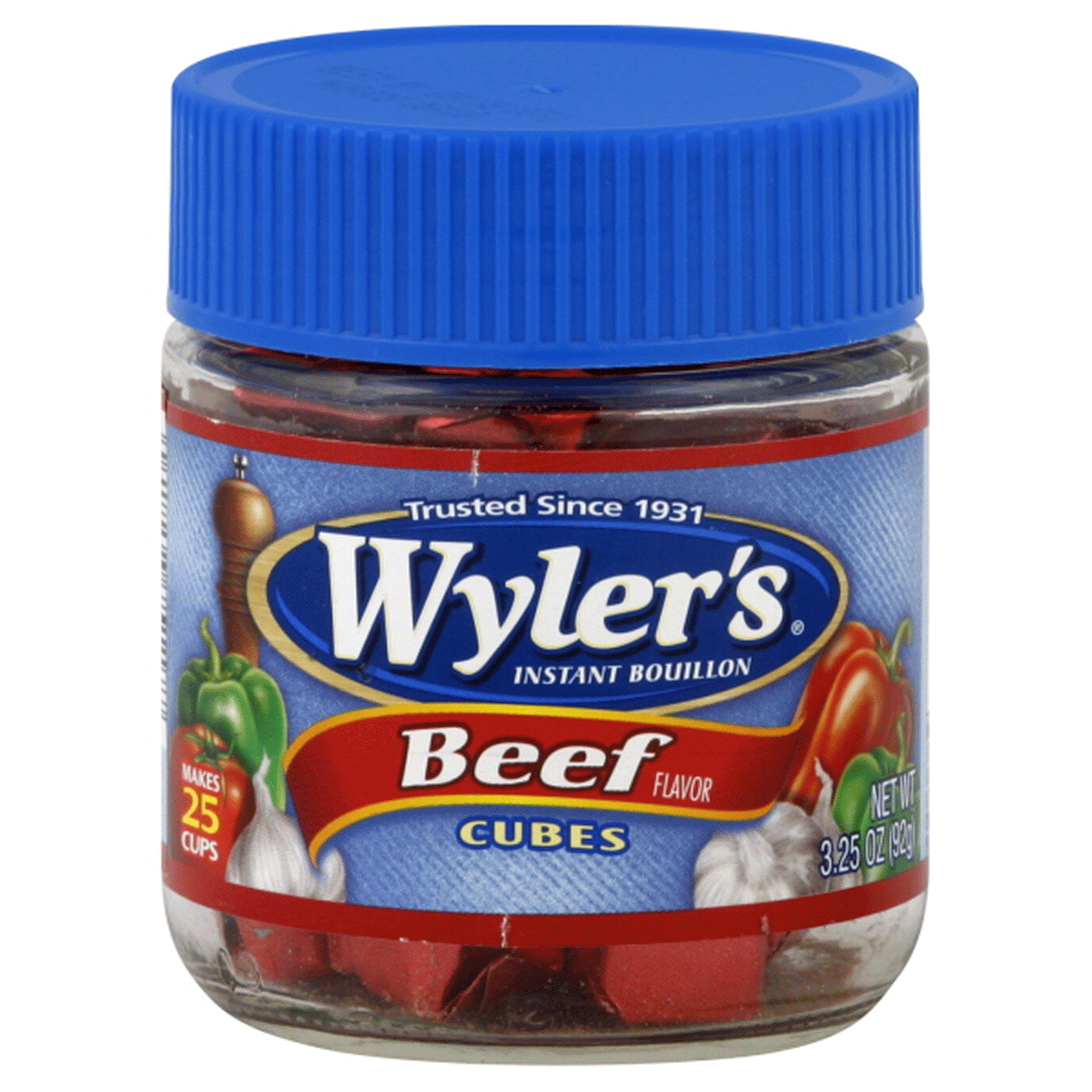
Both "stock" and "broth" are derived from vegetables simmered with meat and sometimes bones. And this is where all the confusion on the difference between the two shows up. Some chefs draw the line between the two at the use of animal bones, stating that stock must be made with bones while broth may not. Other chefs contend that bones are optional for either.
And then there’s vegetable stock and vegetable broth. Neither of these use meat nor bones, confusing the issue even further.
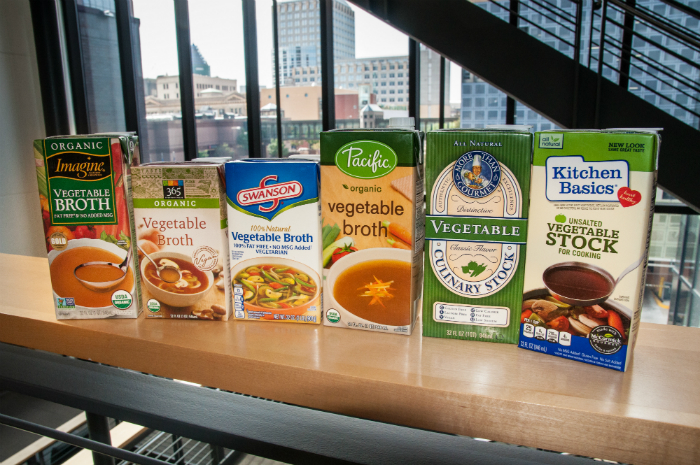
Most often, the line is drawn at seasonings. Use of seasonings is the distinguishing factor. A stock is generally understood to be a rich, unseasoned liquid intended for use as a base for other dishes (sauces, stews and soups, for example). Broth, on the other hand, is seasoned and satisfying all on its own (but can also be used as a light soup base).
The next time you wonder whether you need stock or broth, consider the purpose for which you will use it. If you intend to drink it plain or make a light soup, purchase broth (or better yet, make your own!). If you plan to use it in sauces, thick stews or heavy soups with varied seasonings, purchase stock (or better yet, make your own!).
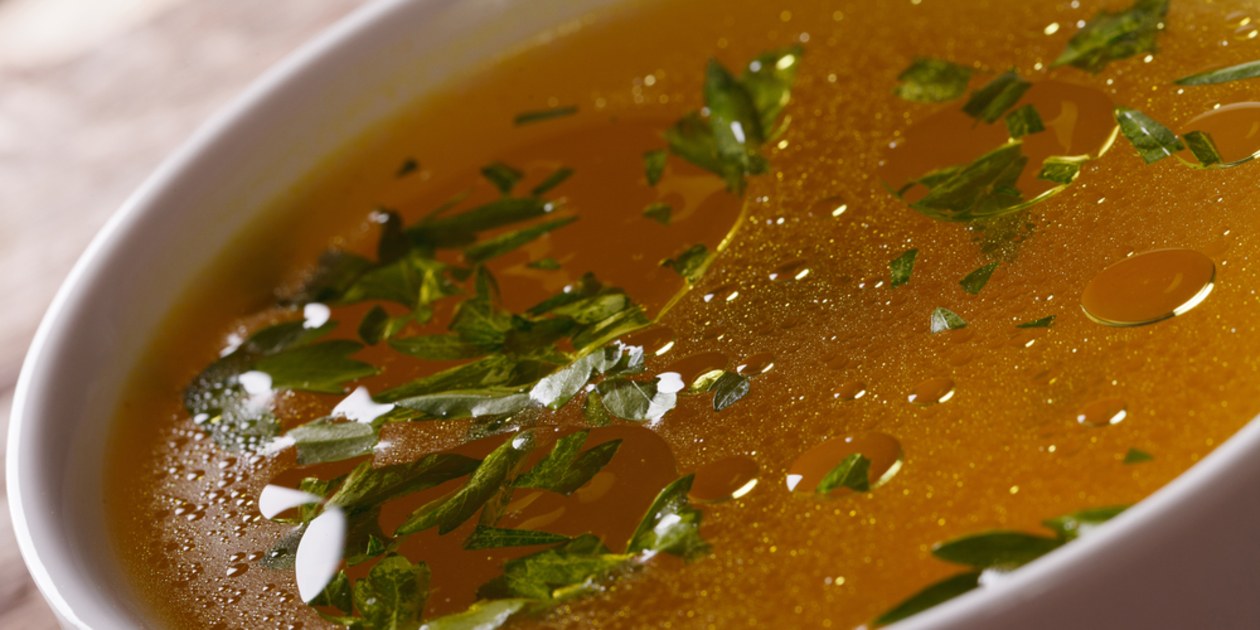
Now not to treat you as stupid, but just to keep it all crystal clear, here’s the re-cap:
So all this said, how about we make our own? Elise Bauer, from www.simplyrecipes.com, shares a no-fail recipe that’s gotten 5 out of 5 stars with over 100 reviewers.

She says that when she was in college and very often sick, her doctor told her to get in the habit of making soup from scratch. But the soup he was referring to was simply bone broth—roasted and boiled beef bones.
So she dutifully complied. But she says she hadn’t the faintest idea what she was doing. After getting bones from her butcher, she boiled them for hours with a rolling boil until the bones were practically disintegrating. Then she removed the bones, added lentils and salt, and ate it. For those of you unfamiliar with the process of making broth, this is NOT the way to do it. (Granted, if you are calcium deficient, and don’t care about the taste of your soup, or the grittiness, it is edible.)
No, the trick with broth is to roast the bones first to get some caramelized flavor going, then to slowly heat them in water until you have a bare simmer. You then let them cook that way, GENTLY, for a good long time. And the seasoning or flavor-enhancers? Try beef scraps or stew meat, as well as aromatic vegetables and herbs. Also a few veal bones will increase the gelatin factor.
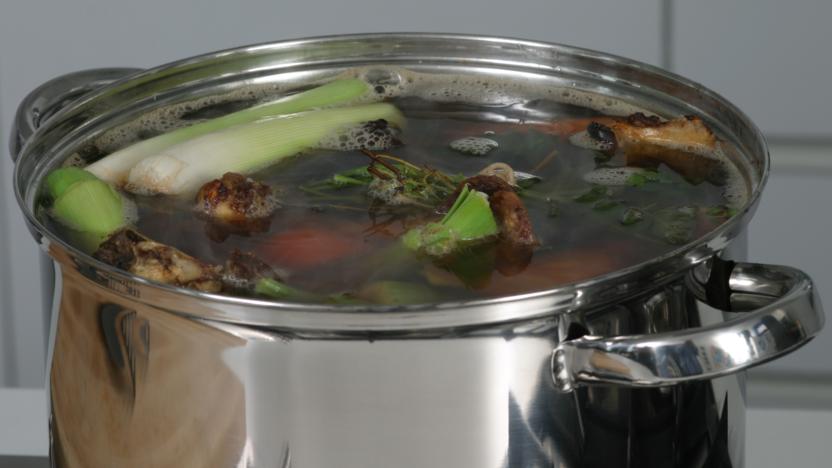
Why make your own beef stock? If you make a big batch and freeze it, you can save some money. But the main reason is that you’ll get a richness of flavor and texture in your homemade stock that you just can’t buy at the store (minus chemical preservatives and other mystery ingredients). Fall and winter is the perfect time to dabble in soup and broth-making. So if you’re inclined, here is Elise’s no-fail recipe:
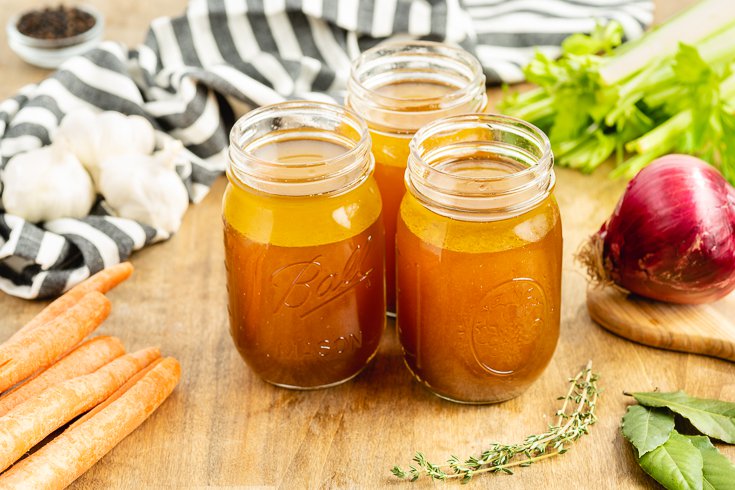

4 to 5 pounds meaty beef bones (with lots of marrow), including some knuckle bones if possible, cut to expose the center marrow, and include at least a couple veal bones if you can, for their gelatin
1 pound beef stew meat (chuck or Crumble Lovers' Sheet-Pan Apple Crumblek steak) and/or beef scraps, cut into 2-inch chunks
olive oil
1 to 2 medium onion peeled and quartered
1 to 2 large carrot cut into 1-2 inch segments
1 handful celery tops, or 1 large celery rib, cut into 1 inch segments
2 to 3 cloves garlic unpeeled
1 handful parsley stems and leaves
1 to 2 bay leaf
10 peppercorns
Directions:
Add Recipe to Cook'n
They are all words for the liquid part of soup, right? Yes... and no. Although these terms are often used interchangeably, professional chefs will insist that there are distinct differences between the three. This is especially true between stock and broth. Unfortunately, even the chefs don't seem to agree on exactly what those differences are.

But there is a little middle ground. And you’ll find it in bouillon. Bouillon is the least controversial. Most chefs use "bouillon" as a term for dehydrated stock or broth that is later rehydrated for use.
Bouillon is commercially produced for home use in the form of cubes and powders. While it can add a solid flavor punch to a recipe, the drawback with commercially produced bouillons is their high salt content.

Both "stock" and "broth" are derived from vegetables simmered with meat and sometimes bones. And this is where all the confusion on the difference between the two shows up. Some chefs draw the line between the two at the use of animal bones, stating that stock must be made with bones while broth may not. Other chefs contend that bones are optional for either.
And then there’s vegetable stock and vegetable broth. Neither of these use meat nor bones, confusing the issue even further.

Most often, the line is drawn at seasonings. Use of seasonings is the distinguishing factor. A stock is generally understood to be a rich, unseasoned liquid intended for use as a base for other dishes (sauces, stews and soups, for example). Broth, on the other hand, is seasoned and satisfying all on its own (but can also be used as a light soup base).
The next time you wonder whether you need stock or broth, consider the purpose for which you will use it. If you intend to drink it plain or make a light soup, purchase broth (or better yet, make your own!). If you plan to use it in sauces, thick stews or heavy soups with varied seasonings, purchase stock (or better yet, make your own!).

Now not to treat you as stupid, but just to keep it all crystal clear, here’s the re-cap:
- BOUILLON is stock or broth that’s been dehydrated.
- STOCK is rich and unseasoned.
- BROTH is rich and definitely seasoned.
So all this said, how about we make our own? Elise Bauer, from www.simplyrecipes.com, shares a no-fail recipe that’s gotten 5 out of 5 stars with over 100 reviewers.

She says that when she was in college and very often sick, her doctor told her to get in the habit of making soup from scratch. But the soup he was referring to was simply bone broth—roasted and boiled beef bones.
So she dutifully complied. But she says she hadn’t the faintest idea what she was doing. After getting bones from her butcher, she boiled them for hours with a rolling boil until the bones were practically disintegrating. Then she removed the bones, added lentils and salt, and ate it. For those of you unfamiliar with the process of making broth, this is NOT the way to do it. (Granted, if you are calcium deficient, and don’t care about the taste of your soup, or the grittiness, it is edible.)
No, the trick with broth is to roast the bones first to get some caramelized flavor going, then to slowly heat them in water until you have a bare simmer. You then let them cook that way, GENTLY, for a good long time. And the seasoning or flavor-enhancers? Try beef scraps or stew meat, as well as aromatic vegetables and herbs. Also a few veal bones will increase the gelatin factor.

Why make your own beef stock? If you make a big batch and freeze it, you can save some money. But the main reason is that you’ll get a richness of flavor and texture in your homemade stock that you just can’t buy at the store (minus chemical preservatives and other mystery ingredients). Fall and winter is the perfect time to dabble in soup and broth-making. So if you’re inclined, here is Elise’s no-fail recipe:

5-Star Homemade Bone Broth
Serving size: 1
Calories per serving: 655.047
Ingredients:
Calories per serving: 655.047
4 to 5 pounds meaty beef bones (with lots of marrow), including some knuckle bones if possible, cut to expose the center marrow, and include at least a couple veal bones if you can, for their gelatin
1 pound beef stew meat (chuck or Crumble Lovers' Sheet-Pan Apple Crumblek steak) and/or beef scraps, cut into 2-inch chunks
olive oil
1 to 2 medium onion peeled and quartered
1 to 2 large carrot cut into 1-2 inch segments
1 handful celery tops, or 1 large celery rib, cut into 1 inch segments
2 to 3 cloves garlic unpeeled
1 handful parsley stems and leaves
1 to 2 bay leaf
10 peppercorns
Directions:
1. Roast the meat, bones, and vegetables: Preheat oven to 400°F. Rub a little olive oil over the stew meat pieces, carrots, and onions. Place stock bones, stew meat or beef scraps, carrots and onions in a large, shallow roasting pan.
Roast in oven for about 45 minutes, turning the bones and meat pieces half-way through the cooking, until nicely browned. If bones begin to char at all during this cooking process, lower the heat. They should brown, not burn.
When the bones and meat are nicely browned, remove them and the vegetables and place them in a large (12 to 16 quart) stock pot.
2. Add hot water and scrape up the browned bits: Place the roasting pan on the stove-top on low heat (will cover 2 burners), pour 1/2 cup to a cup of hot water over the pan and use a metal spatula to scrape up all of the browned bits stuck to the bottom of the pan.
Pour the browned bits and water into the stock pot.
3. Add vegetables, water, bring to a low simmer: Add celery tops, garlic, parsley, bay leaves, and peppercorns to the stock pot.
Fill the stock pot with cold water, to 1 to 2 inches over the top of the bones. Put the heat on high and bring the pot to a low simmer and then reduce the heat to low.
If you have a candy or meat thermometer, the temperature of the water should be between 180° and 200°F (boiling is 212°F). The stock should be at a bare simmer, just a bubble or two coming up here and there. (You may need to put the pot on your smallest burner on the lowest temp, or if you are using an oven-safe pot, place it in the oven at 190°F.)
Cover the pot loosely and let simmer low and slow for 3-6 hours.
Do not stir the stock while cooking. Stirring will mix the fats in with the stock, clouding up the stock.
4. Skim scum and fat: As the stock cooks, fat will be released from the bone marrow and stew meat and rise to the top. From time to time check in on the stock and use a large metal spoon to scoop away the fat and any scum that rises to the surface.
(Do not put this fat down your kitchen drain. It will solidify and block your pipes. Put it in a bowl or jar to save for cooking or to discard.)
5. Remove solids and strain: At the end of cooking time (when you want to end the cooking is up to you, 3 hours minimum, 6 to 8 hours if you can do it) use a slotted spoon or spider ladle to gently remove the bones and vegetables from the pot (discard them, though if you see a chunk of marrow, taste it, it's delicious).
Line another large pot (8-quart) with a fine mesh sieve, covered with a couple layers of cheesecloth if you have it.
Pour the stock through the sieve to strain it of remaining solids.
6. Chill: Let cool to room temperature then chill in the refrigerator.
One the stock has chilled, any fat remaining will have risen to the top and solidified. The fat forms a protective layer against bacteria while the stock is in the refrigerator. If you plan to freeze the stock however, remove and discard the fat, pour the stock into a jar or plastic container. (You can also remove the fat, and boil the stock down, concentrating it so that it doesn't take as much storage space.) Leave an inch head room from the top of the stock to the top of the jar, so that as the stock freezes and expands, it will not break the container.
Roast in oven for about 45 minutes, turning the bones and meat pieces half-way through the cooking, until nicely browned. If bones begin to char at all during this cooking process, lower the heat. They should brown, not burn.
When the bones and meat are nicely browned, remove them and the vegetables and place them in a large (12 to 16 quart) stock pot.
2. Add hot water and scrape up the browned bits: Place the roasting pan on the stove-top on low heat (will cover 2 burners), pour 1/2 cup to a cup of hot water over the pan and use a metal spatula to scrape up all of the browned bits stuck to the bottom of the pan.
Pour the browned bits and water into the stock pot.
3. Add vegetables, water, bring to a low simmer: Add celery tops, garlic, parsley, bay leaves, and peppercorns to the stock pot.
Fill the stock pot with cold water, to 1 to 2 inches over the top of the bones. Put the heat on high and bring the pot to a low simmer and then reduce the heat to low.
If you have a candy or meat thermometer, the temperature of the water should be between 180° and 200°F (boiling is 212°F). The stock should be at a bare simmer, just a bubble or two coming up here and there. (You may need to put the pot on your smallest burner on the lowest temp, or if you are using an oven-safe pot, place it in the oven at 190°F.)
Cover the pot loosely and let simmer low and slow for 3-6 hours.
Do not stir the stock while cooking. Stirring will mix the fats in with the stock, clouding up the stock.
4. Skim scum and fat: As the stock cooks, fat will be released from the bone marrow and stew meat and rise to the top. From time to time check in on the stock and use a large metal spoon to scoop away the fat and any scum that rises to the surface.
(Do not put this fat down your kitchen drain. It will solidify and block your pipes. Put it in a bowl or jar to save for cooking or to discard.)
5. Remove solids and strain: At the end of cooking time (when you want to end the cooking is up to you, 3 hours minimum, 6 to 8 hours if you can do it) use a slotted spoon or spider ladle to gently remove the bones and vegetables from the pot (discard them, though if you see a chunk of marrow, taste it, it's delicious).
Line another large pot (8-quart) with a fine mesh sieve, covered with a couple layers of cheesecloth if you have it.
Pour the stock through the sieve to strain it of remaining solids.
6. Chill: Let cool to room temperature then chill in the refrigerator.
One the stock has chilled, any fat remaining will have risen to the top and solidified. The fat forms a protective layer against bacteria while the stock is in the refrigerator. If you plan to freeze the stock however, remove and discard the fat, pour the stock into a jar or plastic container. (You can also remove the fat, and boil the stock down, concentrating it so that it doesn't take as much storage space.) Leave an inch head room from the top of the stock to the top of the jar, so that as the stock freezes and expands, it will not break the container.
Recipe formatted with the Cook'n Recipe Software from DVO Enterprises.
Sources:
- www.thenest.com
- www.meijer.com
- www.epicurious.com
- www.simplyrecipes.com
- www.splendidtable.org
- www.bbc.co.uk
- www.draxe.com
 Alice Osborne
Alice Osborne
Weekly Newsletter Contributor since 2006
Email the author! alice@dvo.com
